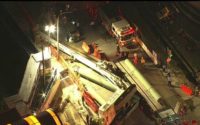Crane operator Thomas L. Bales, 40, overturned his crane into a ditch near Elgin, Neb., in late May while driving to the construction site of Prairie Breeze II, a wind-energy farm Wanzek Construction is building for Invenergy, a wind-energy company. Arnold Jelinek, vice president of Fargo, S.D.-based Wanzek, confirmed the circumstances surrounding Bales' death, one of a gradually rising number of fatalities connected to wind turbines and their construction and maintenance.
In a news release, Darwin Crag, acting Nebraska-area director for the Occupational Safety and Health Administration, said Bales had worked for Wanzek Construction for only 10 days.
"Even though temporary workers may only work on a jobsite a few days, weeks or months, employers still have a responsibility to train all employees, permanent and temporary, about the hazards to which they are exposed," he said. Tradesman International, a staffing agency OSHA says brokered Bales' job with Wanzek, did not respond to ENR's inquiry regarding the victim's skill level .
Crane operators at remote sites often face a combination of rough terrain and high winds with limited and challenging access features, says Graham Brent, spokesman for the National Commission for the Certification of Crane Operators.
"I don't think there's a shortage of training capacity on the union side," said James Waugh, president of the Omaha and Southwest Iowa Building Trades Council. He added that unions have been recruiting more crane operators and adding apprentices to training programs.
Although Wanzek employed a staffing agency to fill its crane operator needs, Jelinek said the wind energy sector itself is not putting unusual pressure on operator capacity.
In contrast to the driving accident involving Bales, the lifts needed to construct turbines are where most of the risk comes into play. "I don't see [a wind-farm pick] being much different than working on a tall building," said Toby Crow, president of the Associated General Contractors, South Dakota.
"A lift is a lift," Jelinek added.
Brent, however, said there has been acknowledgment of the increased risk for crane operators at wind-farms by OEMs. "At least two manufacturers have developed attachments specifically for wind-farm applications," he says. "You can't eliminate risk, but you can mitigate it, so equipment evolution is very important."


Post a comment to this article
Report Abusive Comment